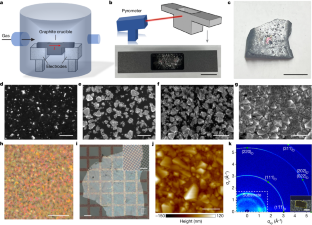2024-04-25 韓国基礎科学研究院(IBS)
<関連情報>
- https://www.ibs.re.kr/cop/bbs/BBSMSTR_000000000738/selectBoardArticle.do
- https://www.nature.com/articles/s41586-024-07339-7
1気圧の液体金属中でダイヤモンドを成長させる Growth of diamond in liquid metal at 1 atm pressure
Yan Gong,Da Luo,Myeonggi Choe,Yongchul Kim,Babu Ram,Mohammad Zafari,Won Kyung Seong,Pavel Bakharev,Meihui Wang,In Kee Park,Seulyi Lee,Tae Joo Shin,Zonghoon Lee,Geunsik Lee & Rodney S. Ruoff
Nature Published:24 April 2024
DOI:https://doi.org/10.1038/s41586-024-07339-7

Abstract
Natural diamonds were (and are) formed (thousands of million years ago) in the upper mantle of Earth in metallic melts at temperatures of 900–1,400 °C and at pressures of 5–6 GPa (refs. 1,2). Diamond is thermodynamically stable under high-pressure and high-temperature conditions as per the phase diagram of carbon3. Scientists at General Electric invented and used a high-pressure and high-temperature apparatus in 1955 to synthesize diamonds by using molten iron sulfide at about 7 GPa and 1,600 °C (refs. 4,5,6). There is an existing model that diamond can be grown using liquid metals only at both high pressure and high temperature7. Here we describe the growth of diamond crystals and polycrystalline diamond films with no seed particles using liquid metal but at 1 atm pressure and at 1,025 °C, breaking this pattern. Diamond grew in the subsurface of liquid metal composed of gallium, iron, nickel and silicon, by catalytic activation of methane and diffusion of carbon atoms into and within the subsurface regions. We found that the supersaturation of carbon in the liquid metal subsurface leads to the nucleation and growth of diamonds, with Si playing an important part in stabilizing tetravalently bonded carbon clusters that play a part in nucleation. Growth of (metastable) diamond in liquid metal at moderate temperature and 1 atm pressure opens many possibilities for further basic science studies and for the scaling of this type of growth.



